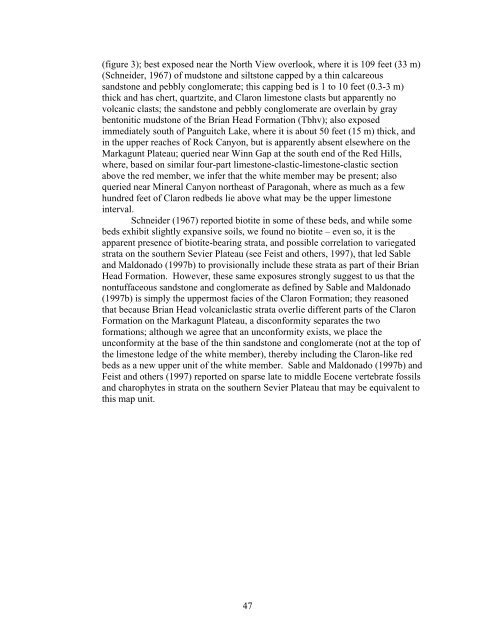Interim Geologic Map of the West Part of - Utah Geological Survey
Interim Geologic Map of the West Part of - Utah Geological Survey
Interim Geologic Map of the West Part of - Utah Geological Survey
Create successful ePaper yourself
Turn your PDF publications into a flip-book with our unique Google optimized e-Paper software.
(figure 3); best exposed near <strong>the</strong> North View overlook, where it is 109 feet (33 m)(Schneider, 1967) <strong>of</strong> mudstone and siltstone capped by a thin calcareoussandstone and pebbly conglomerate; this capping bed is 1 to 10 feet (0.3-3 m)thick and has chert, quartzite, and Claron limestone clasts but apparently novolcanic clasts; <strong>the</strong> sandstone and pebbly conglomerate are overlain by graybentonitic mudstone <strong>of</strong> <strong>the</strong> Brian Head Formation (Tbhv); also exposedimmediately south <strong>of</strong> Panguitch Lake, where it is about 50 feet (15 m) thick, andin <strong>the</strong> upper reaches <strong>of</strong> Rock Canyon, but is apparently absent elsewhere on <strong>the</strong>Markagunt Plateau; queried near Winn Gap at <strong>the</strong> south end <strong>of</strong> <strong>the</strong> Red Hills,where, based on similar four-part limestone-clastic-limestone-clastic sectionabove <strong>the</strong> red member, we infer that <strong>the</strong> white member may be present; alsoqueried near Mineral Canyon nor<strong>the</strong>ast <strong>of</strong> Paragonah, where as much as a fewhundred feet <strong>of</strong> Claron redbeds lie above what may be <strong>the</strong> upper limestoneinterval.Schneider (1967) reported biotite in some <strong>of</strong> <strong>the</strong>se beds, and while somebeds exhibit slightly expansive soils, we found no biotite – even so, it is <strong>the</strong>apparent presence <strong>of</strong> biotite-bearing strata, and possible correlation to variegatedstrata on <strong>the</strong> sou<strong>the</strong>rn Sevier Plateau (see Feist and o<strong>the</strong>rs, 1997), that led Sableand Maldonado (1997b) to provisionally include <strong>the</strong>se strata as part <strong>of</strong> <strong>the</strong>ir BrianHead Formation. However, <strong>the</strong>se same exposures strongly suggest to us that <strong>the</strong>nontuffaceous sandstone and conglomerate as defined by Sable and Maldonado(1997b) is simply <strong>the</strong> uppermost facies <strong>of</strong> <strong>the</strong> Claron Formation; <strong>the</strong>y reasonedthat because Brian Head volcaniclastic strata overlie different parts <strong>of</strong> <strong>the</strong> ClaronFormation on <strong>the</strong> Markagunt Plateau, a disconformity separates <strong>the</strong> tw<strong>of</strong>ormations; although we agree that an unconformity exists, we place <strong>the</strong>unconformity at <strong>the</strong> base <strong>of</strong> <strong>the</strong> thin sandstone and conglomerate (not at <strong>the</strong> top <strong>of</strong><strong>the</strong> limestone ledge <strong>of</strong> <strong>the</strong> white member), <strong>the</strong>reby including <strong>the</strong> Claron-like redbeds as a new upper unit <strong>of</strong> <strong>the</strong> white member. Sable and Maldonado (1997b) andFeist and o<strong>the</strong>rs (1997) reported on sparse late to middle Eocene vertebrate fossilsand charophytes in strata on <strong>the</strong> sou<strong>the</strong>rn Sevier Plateau that may be equivalent tothis map unit.47
















